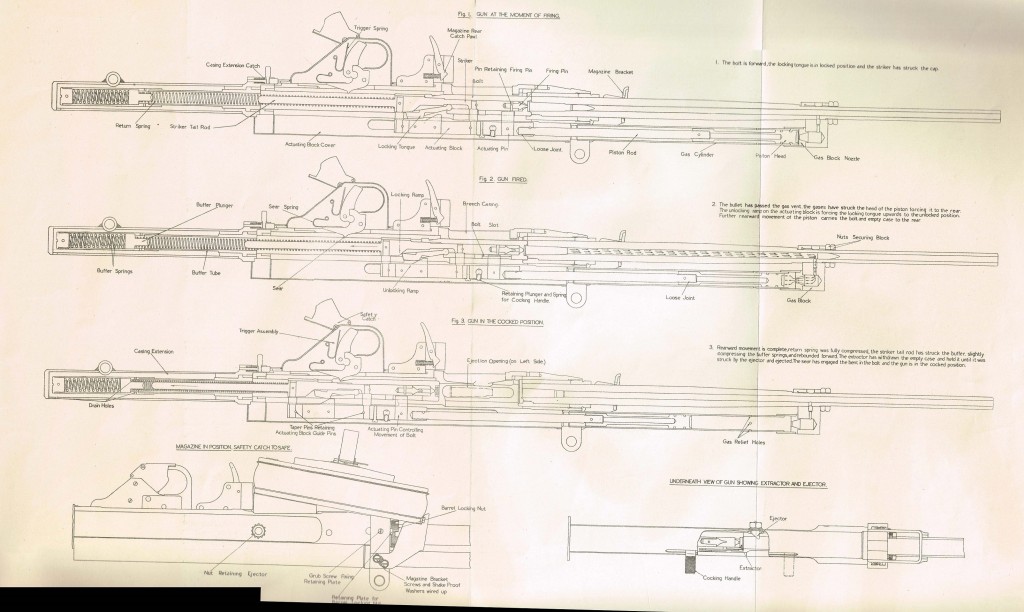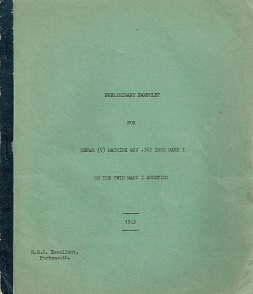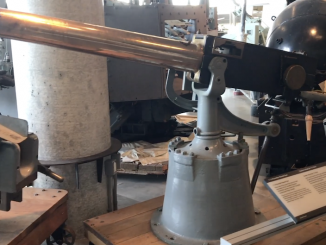The Hefah machine gun was a wartime expedient British light machine gun design. It was created by a private company (the Ductile Steel Company) in 1940, in response to a generalized concern that all LMG production in the UK was concentrated at Enfield, and a successful attack on he complex there could create a huge shortage of machine guns. The Hefah design (apparently named for the firm that would eventually manufacture the few examples of the gun made, instead of the designers) appears to have been loosely based on the Lewis, but heavily modified to make it much cheaper and simpler to manufacture. For example, it used a single pivoting locking wedge, in place of the 2-lug rotating bolt of the Lewis.
For magazines, the Hefah used 100-round Bren drum magazines, which latched to the bottom of the receiver. It seems that one of the immediate problems in trials of the Hefah was a serious lack of clearance between the magazine and ground when firing from a bipod, and one can only imagine the clumsiness of magazine changes with such a system (not even considering the rather finicky nature of the Bren drums in the first place).

Information is very scarce on these guns, but it does appear that the MkV version of the gun was adopted formally in 1942 by the Royal Navy, for use as a light AA gun on small vessels. In this type of application, the impracticalities of the design would be minimized, and the simple manufacturing requirements could be met and allow the acquisition of guns otherwise unavailable to the Navy because of other more pressing demands for Brens. The gun was declared obsolete in November 1944, giving it a remarkably short service life. Presumably by 1944 the most urgent concern over LMG production had passed.
A preliminary manual for the Hefah was published in 1943 detailing disassembly and maintenance of the guns, along with showing cutaway views of the action and a dual mounting setup for naval applications. We have a scanned copy of this manual, which you can download here:
A testing report appears to also be available, and we are currently looking into getting a copy of it from a UK official archive.




Hmmm, this gun uses what is usually a top-mounted magazine to feed from the bottom, but then the drawing shows the gun inverted with the magazine on the top. Clearly meant to confuse Nazi spies!
“For magazines, the Hefah used 100-round Bren drum magazines, which latched to the bottom of the receiver.”
It reminds me of soviet RPD machine gun, it used 100-round belt inside drum-shaped container, it was phased out from service in 1960s by PK machine gun, but it was produced in so great number that it is still used in some local conflict.
http://en.wikipedia.org/wiki/RPD_machine_gun
Erm, mind you, RPD was a belt-fed, and the “magazine” was in fact a cylindrical belt box. And then it hung perpendicular to the bore axis – where’s the resemblance?
Sorry I don’t write it clearly: I don’t insist any technical similarity, only exterior shape – the gun with drum-shaped thing under it can be used with long enough bipod.
Now I notice that Bren 100-rd magazine is mounted in Lewis MG-style. Sorry for my error, I am wont to call this type of magazine as a “pan-magazine” and for example PPSh-41 as “drum-magazine” hence my confusion.
The RPD was actually replaced by the RPK, not byt PK, which is a GPMG and fires the 7.62x54R cartridge.
http://world.guns.ru/machine/rus/degtyarov-rpd-e.html
Sounds, to me at least, that its utter obscurity was and is richly deserved..
If I read the drawing correctly (the upside-down display is weird) it seems like the locking tongue actually is forced forward by the unlocking ramp before the tongue can move down (up in the drawing, towards the magazine) to unlock the bolt.
Hmm. Greasing of the ammunition. Never a good sign…
By late in the war there were loads of Brens available. A large proportion of Bren production occurred in Canada at the Inglis plant in Toronto. Production at Inglis stopped before the end of the war (I can’t find the date just now) because there were more Brens available than there was a need for them. With lots of Brens available, there would have been no more need for stop-gap weapons.
You are right about Bren’s J.Inglis production – they made well over 100k units, primarily for China (Kuomintang). There was article on FW about it: https://www.forgottenweapons.com/john-inglis-and-bren-production/
Then Long Branch was ramping up production after its 1941 completion, but afaik, there was not Bren included in its programme.
I remember seeing in a book pictures of some further Bren development at Inglis including belt feed, some casting or forging to reduce cost of machined parts and so on. Inglis factory is long time discarded as is Long branch armory. Canada has no more MG’s production on its soil.
After rummaging through my references, the only mention of the beast I could find was in Military Small Arms of the 20th Century by Hogg & Weeks.
It’s short enough to quote in full;
If I have to guess, I’d say the gun was intended for AA use by the coastal transports which in 1940-41 were being harried by the Luftwaffe’s maritime units all up and down the Channel. But by the time it was ready for issue (late 1942 to early ’43), that problem really no longer existed mostly due to Allied air dominance over Western Europe.
Also, the pamphlet states that the gun requires lubricated ammunition. Whether this is a naval storekeeper’s precaution against salt air corrosion or an indicator of poor primary extraction, I don’t know. Considering the diagram and description, I suspect both.
The pamphlet further states the gun must be protected against the elements, and lubricated with mineral oil. And that detailed stripping for cleaning is necessary, but basically inadvisable for anyone but an armorer.
None of these factors is exactly reassuring in a machine gun intended for use at sea. Mainly by merchant seamen who had other things to do between raids besides cosset a finicky LMG.
It adds up to a weapon that wasn’t up to the job. Fortunately, by the time it was ready for issue, the “job” pretty much was over with. The Luftwaffe’s coastal attackers were largely gone, and the remainder had other things to worry about than the Hefah. Typhoons and Mustangs, mostly, plus Fleet Air Arm “Martlets” (Wildcats).
.303 LMGs are a minor concern when you can bring 4 x 20mm cannon or 6 x .50 cal MGs to the ball at over 300 mph.
cheers
eon
What I don’t understand is why a new LMG design was needed? Was the Hefah Company unable to produce the Bren, but they wanted to give it some MG to produce for Naval AA purposes? Or did they (the RN) fear that the Army would take all Brens to its own use and leave nothing for the RN, so a new design was adopted to prevent that?
This is speculation, but…
At the time the RN had a standard policy of establishing their own lines of supply for small arms, less for fear of the Army taking the lot than what might be called the “not invented here” syndrome, the idea that the soldiers didn’t understand what sailors needed.
In the Great War, it was the Navy that adopted the .455in Webley automatic, and then the Colt .455in version of the 1911, not the Army. Similarly, in the second go-around, the Navy had their own SMG right through, the Lanchester, a copy of the German MP28 made by the Sterling Engineering Company. (The RN had the last laugh, though; the Lanchester gave rise to the George Patchett-designed Sterling SMG that eventually replaced the Sten.)
The RN had chronic problems with production priorities through the mid-’43 period. Mainly, they were always getting whatever was left after the Army and RAF got their portion. (See The Secret War aka Secret Weapons of World War II aka Wheezers and Dodgers by Gerald Pawle.)
It wouldn’t be fair to say that Lord Beaverbrook, the minister for production, had it in for the Navy, but he certainly had a warm spot in his heart for the RAF. (Read “The Gun From Switzerland”, Chapter Six of Pawle’s book, for an example.)
With all this in mind, and a general shortage of MGs period (early on, the were shuttling a few dozen Lewis and VGO guns back and forth from one port to another to stick on coasters, according to Pawle), and the RN was pretty much in a position where they needed just about any sort of LMG that would work, that they could more-or-less be assured of a steady supply of.
Seen in this light, the decision to adopt the admittedly less-than-terrific Hefah makes some sense. A few hundred manufactured as fast as possible and distributed among the coastal transports would at least throw a scare into the Ju88s and Ju87s, because they wouldn’t know that it wasn’t a pair of water-cooled Vickers-Maxims down there hammering away at them. Especially firing tracers.
But of course, by the time they were deployable, those 88s and Stukas weren’t around any more. They’d lost too many arguments with RAF Fighter Command and the U.S. 8th and 15th Air Forces.
The Hefah, good or bad or indifferent, just wasn’t needed at that point. Not least because IIRC, by late ’42 what coasters which were still being annoyed by gents with crosses under their wings were mainly shooting back with American Browning .30 and .50 MGs, courtesy of Lend-Lease.
Either one of which was a bigger “discourager” than a redeployed infantry LMG with a 100-round Bren AA drum stuck on. Even mounted in pairs.
cheers
eon
Speaking of ridiculous stuff going to the Royal Navy, try the Holman Projector. It was basically a ship-board pneumatic mortar tossing Mills bombs at attacking planes (very optimistic, isn’t it?). The Mark 2 version was test fired using beer bottles as the projectiles! While the Holman Projector wasn’t too good at hitting any Iron Crosses, it actually succeeded in scaring the Luftwaffe because of the very thick smoke that the thrown grenades left in the air. The Germans in this case assumed that the ship they were targeting had something much bigger and much more deadly. But I doubt that a Ju-88 would like a beer bottle to the face!
Then of course there was the steam-powered version of the Holman. It wouldn’t “cook off” a Mills bomb, but using it for potato-duels between passing merchies would probably have made almost as big a mess as, oh, I don’t know, firing a 3-inch UP rocket projector with the back end of same pointed at a lazarette full of spuds.
Pawle’s book is funny as heck at a lot of points.
cheers
eon
Seems like taking a magazine that was designed to feed downward, and without modification requiring it to instead feed upward, is such an obviously bad idea that I can’t understand why anybody would want to do it.
Since the Hefah action is basically a Lewis action, complete to having the action rod and recoil spring below the barrel bore line, it makes even less sense. If I’m reading the diagram correctly, it fed upward and ejected upward, which given its likely poor primary extraction and probable consequent low bolt velocity seems like a recipe’ for smokestack jams. (This may be one of the problems that Hogg & Weeks allude to that showed up in the 1940 trials.)
Putting the “pan” on top, and ejecting downward rather like the Lewis or the Russian DP light, would have made a lot more sense.
Incidentally, the DPM, a modified version of the DP that came into service in 1943-44, had its recoil spring in a tube that stuck out behind the receiver like the Hefah. The original DP had its recoil spring around the piston rod under the barrel where barrel heat soon wrecked its temper. Putting it “out back” solved the problem.
So that’s at least one thing the Hefah’s designers got right.
Better than nothing, I suppose.
cheers
eon
British had been traditionally doing things upside-down; just their way to fly. In this case however, one would think that it may have good effect to sight picture, although just in limited sense.
Here, are some pictures
http://forum.axishistory.com/viewtopic.php?t=169444
Eon’s January 6th, 2015 @ 1:00 P.M. comment with the appropriate quotation from Ian Hogg’s book says it all. I was going to say essentially the same thing as Eon did, but he got there first :).
I first read about the Hefah MG many, many years ago in another of Hogg’s well-known publications, “Machine Guns”, where the text of the description quoted by Eon was essentially identical. However, Eon did omit part of a most telling conclusion in Hogg’s description of the Hefah — “It was declared obsolete in November 1944, which in itself is something of a condemnation – you don’t get rid of a machine gun during a war unless it is a completely hopeless case”.
Wartime expediency gives rise to many different attempts at stop-gap fillers aimed at minimal cost and quick availability, frequently at the cost of efficiency and reliability, and the Hefah appears to fall squarely into this category. On the other hand, it may just possibly have been a basically sound design that had certain faults imposed by wartime compromises that, if properly addressed, might have resulted in a reasonably satisfactory machine gun after all. Ian’s ( as in Ian McCollum’s ) experiences testing and evaluating the much-maligned Chauchat LMG would be a case in point regarding this matter.
Thanks for the addendum, Earl. Hogg omitted that last bit in MSA.
I think my vote for the most unfortunate (I wouldn’t go so far as to say “egregious”) LMG design was the crop of 6.5mm straight-blowback box magazine fed “training” LMGs used by the Imperial Japanese forces during WW2. Basically SMG-type actions, they were probably even less durable than the “Sho-sho”. (Actually, the Chauchat’s doughboy nickname sounds vaguely Japanese. Hm.)
According to W.H.B. Smith (Small Arms of the World, 9th ed.), at least five different patterns of these weapons were encountered by UN forces in Korea. he also stated that they were probably intended for use with a reduced charge round. (I’d hesitate to use them with anything more emphatic than an 8mm Nambu pistol load equivalent.)
I’m wondering two things;
1. How many were original, and how many were local “copies” made up to supplement the small-arms armory of the NKPA before the PLA intervention; and
2. As for the original(s), were they a product of the Kwantung Army in Manchuria (which seems to have been practically a semi-autonomous state from about 1935 to VJ Day?
I’d love to see a feature on these odd MGs, assuming Ian hasn’t already done one.
However, I rather doubt a live-fire session would be advisable on safety grounds. Rather less so than a Chauchat, actually.
cheers
eon
Quite, so, Eon, quite so. And your suggestion about ( more in-depth ) articles on the odd MG’s is a very good idea, I think. Perhaps Ian will be able to clarify this?
I reckon the NKPA was fairly desperate for sufficient infantry MG’s in the early stages of the Korean War, and thus used whatever they could get their hands on — sounds rather familiar, doesn’t it?
I have seen the number of Hefah guns manufactures in an official table of MG production in WW2. I can’t lay my hands on it now but it is the only figure I have seen in print and was around 3,000 guns.
Very few reside in museums in the UK but other than that I am not aware of any in private ownership.
Regards
AlanD
Sydney
I am currently in the process of reading and reviewing ‘British Naval Trawlers and Drifters in Two World Wars’ Lambert & Dunn, Seaforth, 2021. It is full of drawings made by the late John Lambert from his extensive researches and includes, in its coverage of the ‘Round Table’-class minesweeping trawler ‘Sir Kay’, an illustration of the Hefah on a MkI twin mounting, the caption stating ‘fitted to Sir Kay & other later units of the class’. It appears they were mounted on the bridge. Later units of this class were completed in February and March 1943. Other armament appears to be a 12pdr gun forward and a 200m Oerlikon cannon aft.
…that should be 20mm Oerlikon cannon aft.